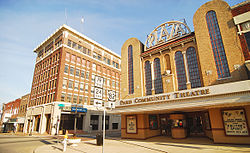Paris, Texas
| Paris, Texas | |
|---|---|
| City | |

Historic downtown Paris
|
|
 Location of Lamar County |
|
 |
|
| Coordinates: 33°39′45″N 95°32′52″W / 33.66250°N 95.54778°W | |
| Country | United States |
| State | Texas |
| County | Lamar |
| Government | |
| • City Council | Mayor Dr. Anjumand Hashmi Aaron Jenkins Billie Sue Lancaster John Wright Richard Grossnickle Matt Frierson Cleonne Holmes Drake |
| • City Manager | John Godwin |
| Area | |
| • Total | 44.4 sq mi (115.0 km2) |
| • Land | 42.8 sq mi (110.7 km2) |
| • Water | 1.7 sq mi (4.3 km2) |
| Elevation | 600 ft (183 m) |
| Population (2000) | |
| • Total | 25,898 |
| • Density | 605.7/sq mi (233.9/km2) |
| Time zone | Central (CST) (UTC−6) |
| • Summer (DST) | CDT (UTC−5) |
| ZIP codes | 75460-75462 |
| Area code(s) | 903/430 |
| FIPS code | 48-55080 |
| GNIS feature ID | 1364810 |
| Website | paristexas.gov |
Paris, Texas is a city and county seat of Lamar County, Texas, United States. As of the 2010 census, the population of the city was 25,171. It is situated in Northeast Texas at the western edge of the Piney Woods, and 98 miles (158 km) northeast of the Dallas–Fort Worth Metroplex. Physio-graphically, these regions are part of the West Gulf Coastal Plain.
Following a tradition of American cities named "Paris", the city commissioned a 65-foot (20 m) replica of the Eiffel Tower in 1993 and installed it in the square. In 1998, presumably as a response to the 1993 construction of a 60-foot (18 m) tower in Paris, Tennessee, the city placed a giant red cowboy hat atop its tower. The current tower is at least the second Eiffel Tower replica built in Paris; the first was constructed of wood and later destroyed by a tornado.
Lamar County was first settled to the west of Jonesborough and Clarksville. A settlement on the Red River was named Fulton, one developed at what is now called Emberson, one to the southeast of that near where today is the North Lamar school complex; a fourth, Pinhook, developed southwest of that at the Chisum-Johnson community; another group of pioneers settled to the east at Moore's Springs.
In late 1839, George W. Wright moved from his farm northeast of Clarksville to a hill where he had purchased 1,000 acres of unoccupied land. It was on the old road from the mouth of the Kiomatia River at its confluence with the Red River to the Grand Prairie. Wright opened a general store on the road. By December 1840 the new county was organized, named for Republic of Texas President Mirabeau B. Lamar. By September 1841, Wright's store was called Paris and served as the local postal office.
In August 1844, the county commissioners took Wright's offer of 50 acres and made Paris the county seat. The area of present Lamar County was part of Red River County during the Republic of Texas. By 1840 population growth had demanded organization of a new county. Wright, who had served in the Third Congress as a representative from Red River County, was a major promoter of the founding of Lamar County, which was established by act of the Fifth Congress of the Republic on December 17, 1840. It was organized by elections held on February 1, 1841. The county included much of what was later separated as Delta County in 1870, an act that reduced Lamar County to its present size.
...
Wikipedia
